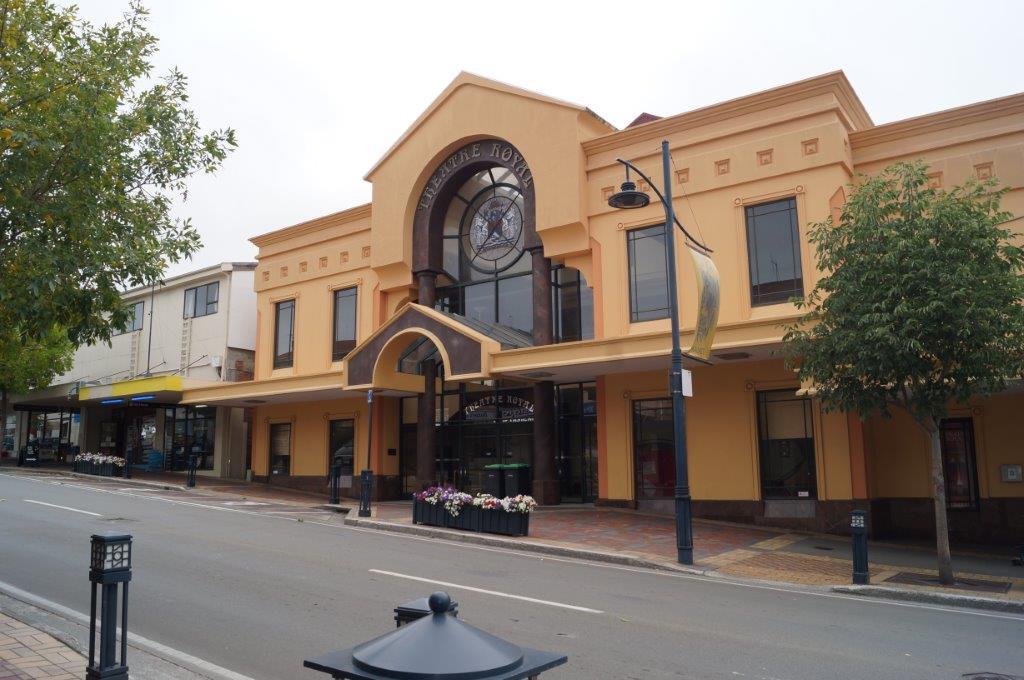 POLICY AND DEVELOPMENT COMMITTEE
FOR THE MEETING ON 4 MARCH 2014
POLICY AND DEVELOPMENT COMMITTEE
FOR THE MEETING ON 4 MARCH 2014
Agenda Item No
Prepared by:
Matt Ambler
Property Manager
Theatre Royal Feasibility Study
_______________________________
Purpose of Report
This report looks at and gives options for the future use of the Council’s assets within
the Theatre Royal, and development of adjoining properties, also owned by Council.
Also to be considered as ancillary to the report, shall be a review of existing services
and facilities currently provided within the Theatre.
Background
Land and Buildings
Council owns the land and buildings as shown on the attached plan (Aerial - Appendix
one). These include the Theatre itself at 118 – 124 Stafford Street, the two closed
commercial properties at 126 and 128 Stafford on the north side of the Theatre.
Council also owns the service lane, accessed from Barnard / George Streets, and the
building known as the Army hall, at 31 Barnard Street.
Timaru District Council
Policy and Development Committee
#832093
1
4 March 2014
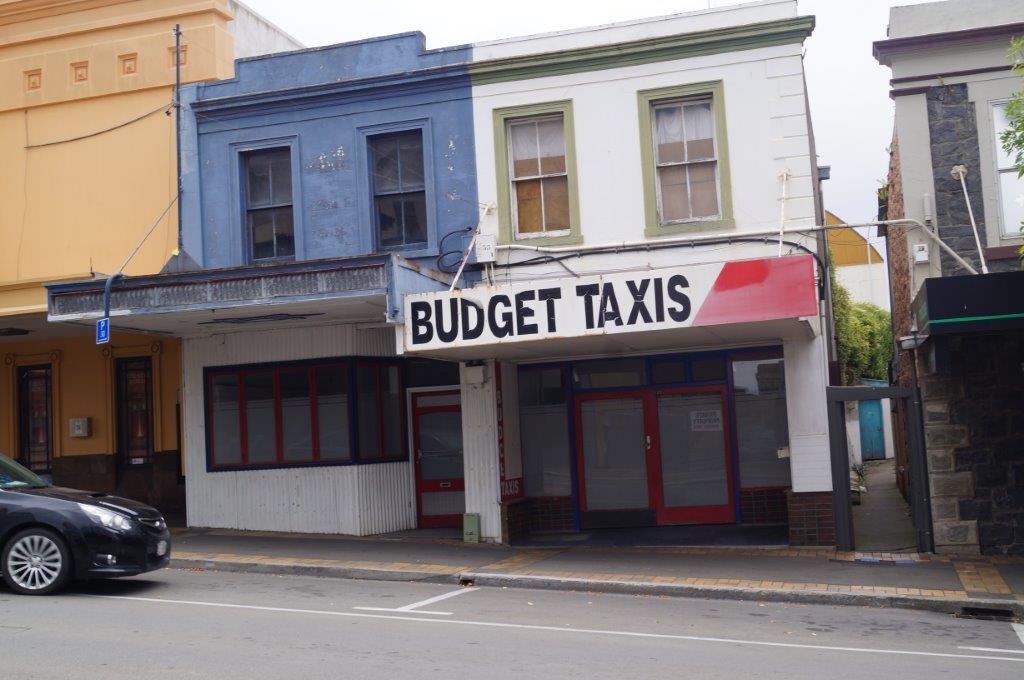
Theatre Building
The Theatre Royal has existed on the site since 1877, and was in private ownership up
until 1961, when Timaru City Council acquired the building.
The existing auditorium and rear of house were built in 1911. The main exterior
structure is brick, of a four layer thickness. Seismic strengthening steel was affixed to
the exterior of the auditorium in 1992/93, in conjunction with the foyer upgrade.
The north side of the ground floor of the auditorium is below ground level. At ground
level, adjacent to the outer wall, there is a vehicle access to the store room door with
also serves as a ‘means of escape’ route from the upstairs seating area. There is an
additional flight of stairs from the downstairs seating area which comes up to ground
level.
The structure holding the main auditorium also includes the higher stage tower, with its
internal mechanical stage support systems, the changing rooms and toilets/showers,
and main stage access doors for props/vehicle services.
This brick structure is defined as a Category B classified building in terms of the Timaru
District Council’s District Plan. As such, the Historic Places Trust and associated
legislation have relevance, when considering any proposal involving alteration to the
auditorium of this structure.
The existing entrance foyer was reconstructed in 1992/93, replacing a previous
structure.
The prime structural element of the foyer is concrete, being the basis of the floor slab
and structural walls, and is structurally connected to the auditorium.
The architectural style is described as an amalgam of classical styles, drawing on
various common forms used.
126 and 128 Stafford Street
Timaru District Council
Policy and Development Committee
#832093
2
4 March 2014
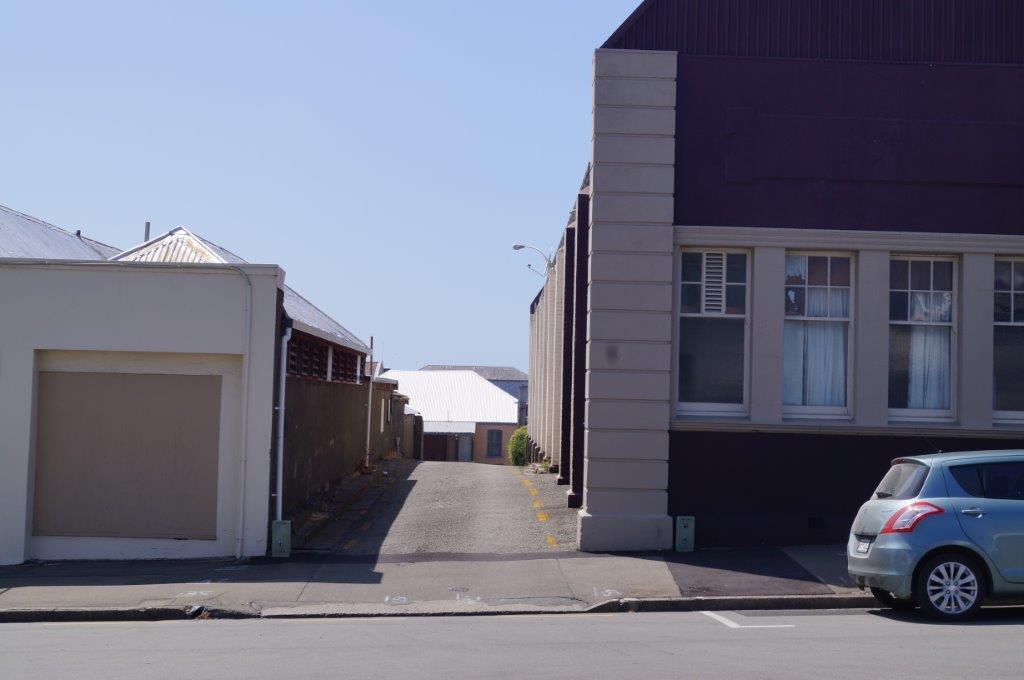
There are two properties adjacent to the immediate north side of the theatre, at 126
and 128 Stafford Street. Both these buildings are believed to be pre 1935 structures,
containing a mix of building elements. Neither has a current purpose in terms of the
Theatre, and they are both suitable for clearance; however their combined street width
of nearly 10 metres does afford an opportunity for future development. This shall be
expanded upon further in a later section of this report.
These two buildings were purchased separately by Council within the last 5 – 10 years,
because of their potential for an expansion of the Theatre functions. They are both
currently vacant, and in poor condition.
Army Hall
The property known as the Army Hall (built 1924) at 31 Barnard Street was purchased
by Council in 2010 for strategic purposes. The site adjoins the existing car park,
(capacity for 32 cars) known as the Barnard Street car park. The building occupies the
entire site, in two adjoined sections. The north section (gym hall with barrel vault roof)
and south section (admin offices over secure parking area) are built of brick masonry.
Both halves are in poor condition, but under temporary occupation pending direction on
its future use.
Vehicle Access
Vehicle access to the rear of the Theatre, for the stage, kitchen and plant room (diesel
fired boiler for the auditorium) is via a service lane. The service lane has two
entrances, from Barnard Street and George Street, meeting at the start of the loading
dock leading to the Theatre rear.
The service lane is (average) 4 metres wide, and is also used for service vehicles to
the rear of those commercial properties on Stafford Street.
Vehicles bringing sets and equipment to the rear/stage of the Theatre currently either
reverse in from George Street, a distance of 60 – 80 metres, or nose in from Barnard
Street, (55 metres) and are required to make a hard left turn, pointing towards George
Street before reversing into the loading dock.
Timaru District Council
Policy and Development Committee
#832093
3
4 March 2014

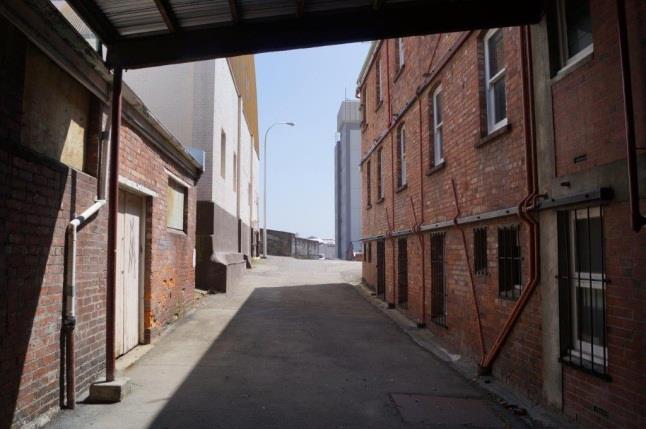
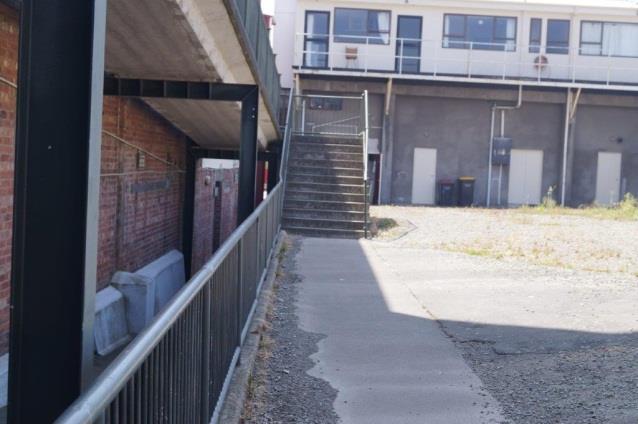
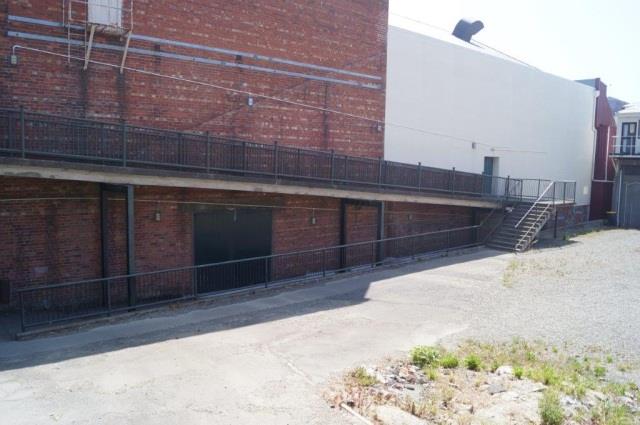
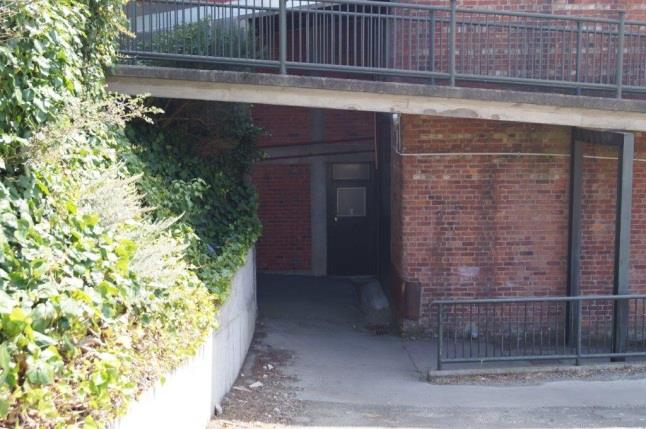
The width of the service lane has remained unchanged since its construction. A view
on its modification to accommodate the type and size/length of vehicle in
common/modern use is in a later section of this report.
The loading dock has a sloping roof of 3.4 – 2.6 metres height, and is 4 – 5 metres
deep. There is a retaining wall at the rear of the loading bay, which supports the
pedestrian ramp from the Barnard Street car park, located next to the Army hall
building. Larger trucks need to stop short of the dock roof to lower their tailgate for
unloading sets.
Pedestrian access to the Theatre is from Stafford Street, or by pedestrian access from
Barnard Street, which passes along the south side of the Theatre building. The access
is on Council land.
The access provides a link through to the Barnard Street parking area, but only for fully
mobile public. The ramp from the car park will access to/from the fire exit doors in the
circle seating area, but steps currently preclude further disabled access to street level.
Pedestrians may access Barnard/Stafford Street by use of the service lane/loading
dock area. However, it has limited lighting which does not fully illuminate the
passageway. It is also open to weather elements, which reduces its attractiveness.
Timaru District Council
Policy and Development Committee
#832093
4
4 March 2014

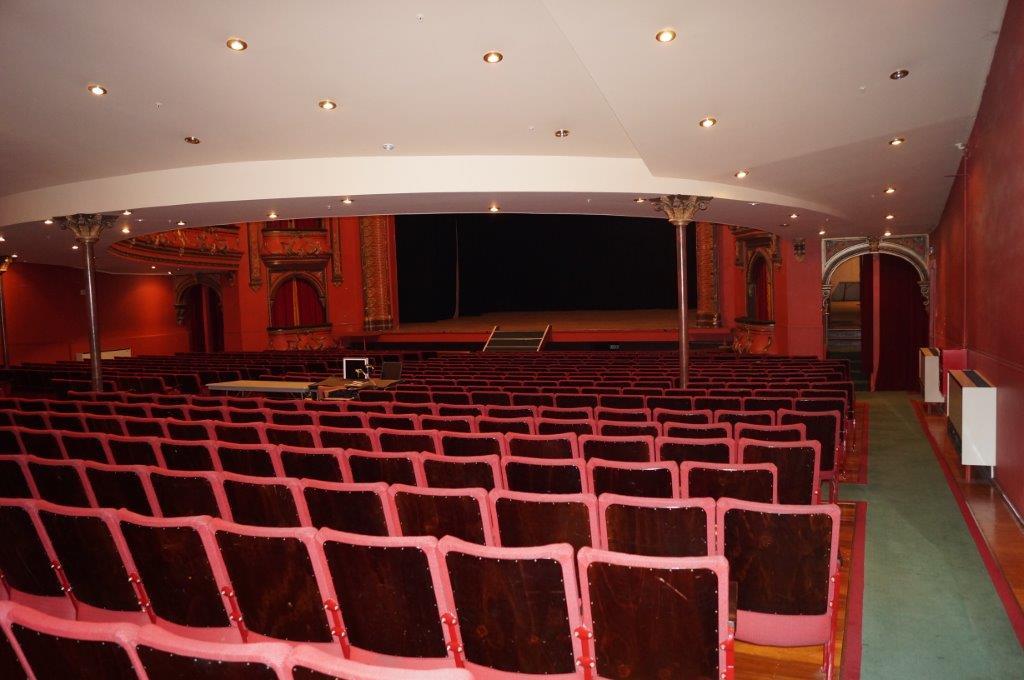
Current Theatre Facilities
Auditorium
The Theatre is essentially repertory in function, that is, a venue for plays, musical
performances, travelling revues, and various local public functions, such as church
groups and school prize giving award ceremonies.
The stage, which has a 1 in 36 degree slope, was constructed in early 20th century with
the auditorium, for shows of the day, such as musicals and drama performances.
These are still the predominant types of performances held in the Theatre, together
with one-night travelling show circuits, such as ‘tribute’ tours. There is a small
orchestra pit at the foot of the stage front, which can accommodate up to 12 musicians.
The slope of the stage and the corresponding slope of the auditorium floor enable the
downstairs audience to have a full view of performers and set to floor level.
The rear stage width is 20.2 metres. The proscenium (stage opening) is 9.7 metres
wide, with a height of 7.3 metres, which qualifies as a medium theatre size.
Timaru District Council
Policy and Development Committee
#832093
5
4 March 2014



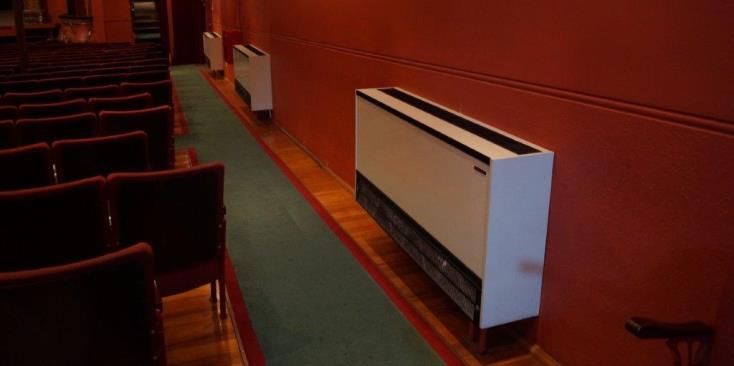
The stage lighting and curtains are suspended overhead on a series of battens and
galvanized pipes on hemp ropes. Raising and lowering of the overhead stage
equipment is carried out by using the rope-operated flying system, which is fixed to
points in the stage tower roof. This area is called the fly floor, approximately 8 metres
above the stage. Lighting, flying of overhead equipment, and installations are carried
out by certified technicians.
The total seating in the auditorium totals 1024. The exact age of the seats is not
known, but their style suggests that they were installed in the 1960’s. The split is 655
ground floor / 369 upstairs circle. The seating is accessed on the ground floor by two
double doors, at either side of the foyer. There are 3 aisles, including a centre aisle
accessed from within the ground floor. Upstairs seating is reached by one double door
from the upstairs foyer. The seating is mounted on fixed stepped rows to give patrons
views of the stage. All seats have arm rests and tilting bases. There is space on the
ground floor to accommodate wheelchairs.
Aisles are carpeted, and floors are tongue / groove, with stained varnish finish.
Heating in the auditorium is provided by water-heated radiators mounted on the internal
walls; the water in turn is heated by a diesel-fired boiler, which is housed in a specific
building adjoining the loading dock. The heated air rises to the upstairs seating, from
where it is dispersed by vent chutes in the circle area ceiling, and recirculated by fans
back into the rear stalls area.
Timaru District Council
Policy and Development Committee
#832093
6
4 March 2014
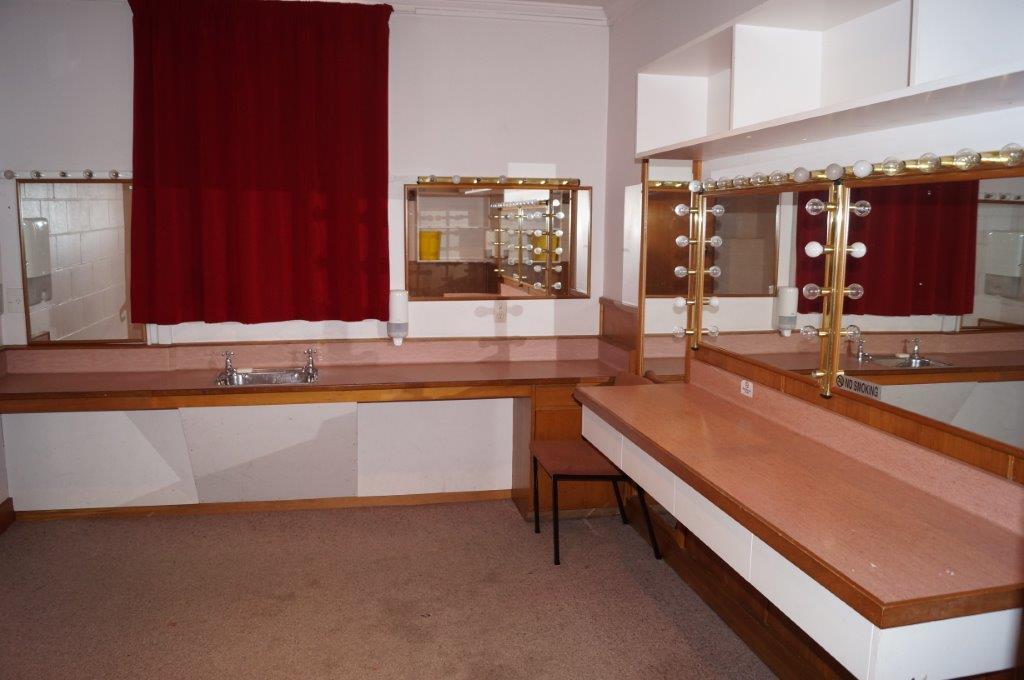
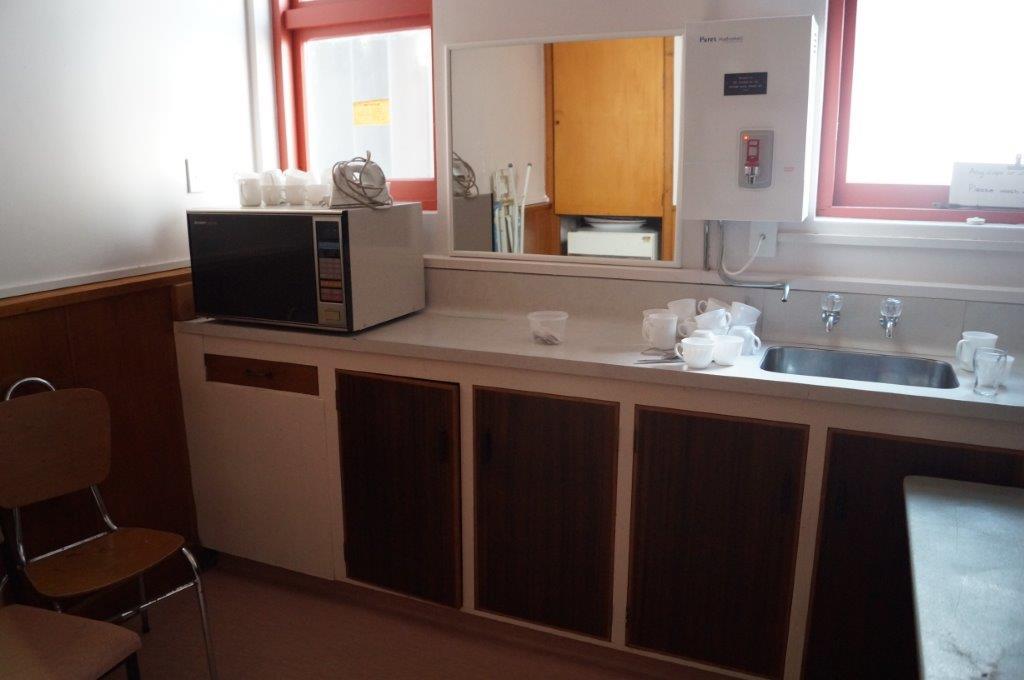
There are no stand alone wall mounted heaters upstairs. The heating and ventilation
systems are currently undergoing tests, to maximize efficiency.
“Back of House” is a term used to describe the performers’ facilities. These are housed
on three floors behind the stage. There are eight dressing rooms, with mirrors and
lighting, including one double size dressing room. Total capacity would be 50 – 60
performers.
There are toilets and showers on each floor, which are accessed by two flights of stairs
from either side of the backstage corridor. Floor coverings are a mix of carpet and
vinyl. Stair wells and corridors have recently had the carpet replaced.
There is also a kitchen at the ground floor with facilities for tea making and food heating
(zip, microwave, fridge and sink bench). These facilities are functional, and restricted
by space constraints.
The carrying capacities of the changing rooms are deemed to be adequate for the style
of performances, and cast numbers, following consultation with the South Canterbury
Drama League, the most frequent large user group. Ongoing maintenance and
updating is considered sufficient for the existing facilities.
Timaru District Council
Policy and Development Committee
#832093
7
4 March 2014

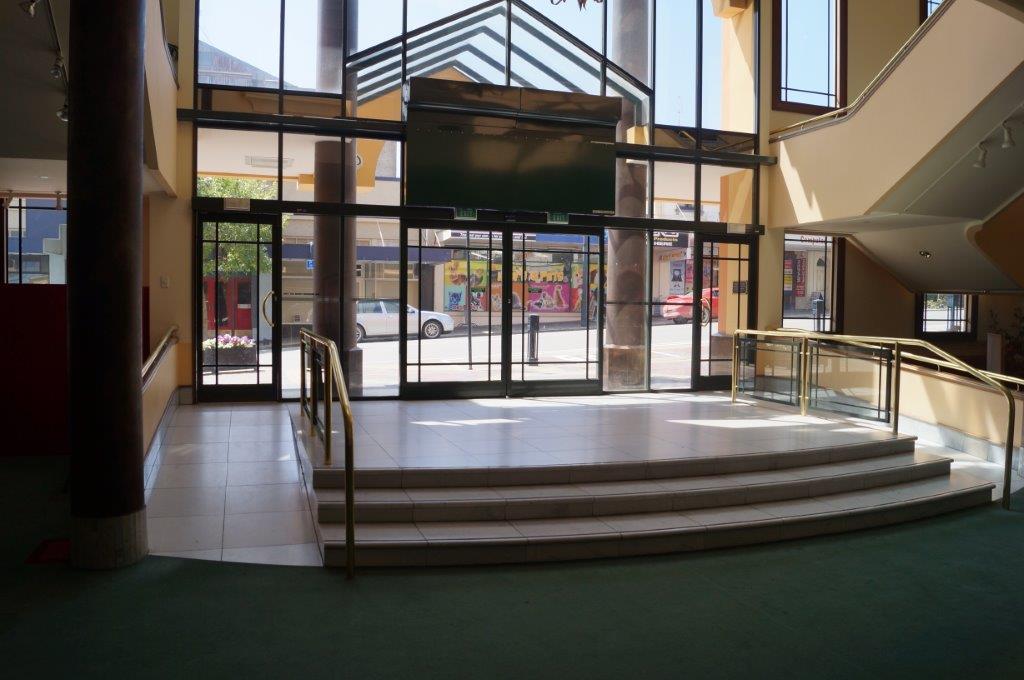
Foyer
The foyer is the initial point of entry, and a prime focus point for pre-show and
intermission mixing and social contact. Entry is through automated double doors,
passing under a heat curtain, and two single doors either side of the entrance landing,
leading to ramps for patrons with mobility issues.
The marble surface landing inside the double doors is a prominent feature, allowing
patrons to gain an initial elevated view of the ground foyer and other patrons.
Other design features of the foyer include the open void above the entrance to the roof
atrium, allowing natural light, as well as a luminescent display of lighting for night
shows. The paired stairwells access the smaller upstairs foyer landing.
There is seating for up to 60, with some restored sections of historical theatre seating
units on display and for use.
Timaru District Council
Policy and Development Committee
#832093
8
4 March 2014
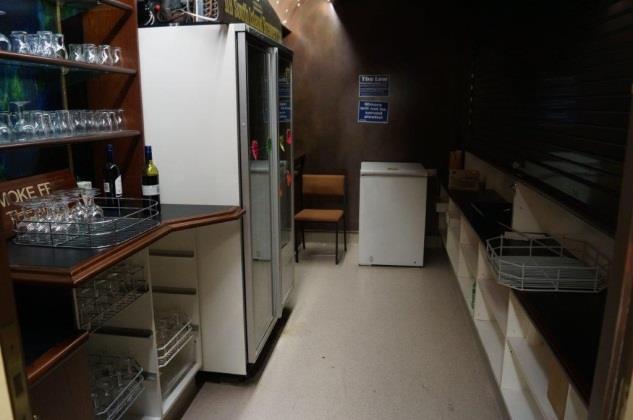
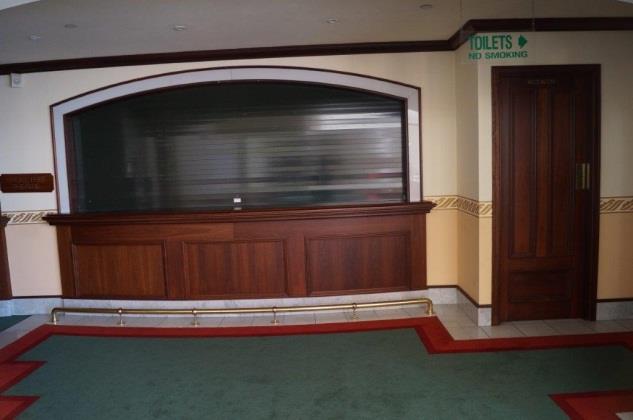
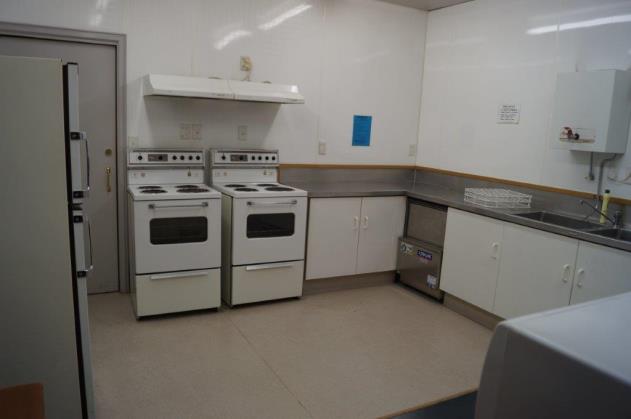
At ground level, there are toilets as follows:
Male 2 cubicles, 1 for disabled use.
Female 5 cubicles, incl.1 disabled use.
There is also a bar/servery, Manager’s office, and minor storage to one side (north
side) of the foyer.
At the time of construction (1993), physical area constraints limited toilet numbers, and
access to the same caused congestion at the point where the toilet entrance corridor
also met with bar patrons, emphasized more when patron numbers are high.
At the centre of the foyer facing the double doors at the entrance is a ticket office for
sales of tickets for walk-up patrons who have not pre-booked. The position of the ticket
box is taken from a traditional perspective, where queues for tickets could lead directly
to the entrance doors. This would allow other patrons to access the other foyer
facilities and auditorium.
On the South wall, near one of the auditorium entrance doors, is a small mechanically-
driven service lift, installed four years ago. The lift was constructed in conjunction with
local Theatre enthusiasts, the Friends of the Theatre Royal, a charitable Trust.
White it does not meet the minimum size standards for a standard passenger lift – its
size is restricted because of its position in relation to the external pedestrian access
path on the south side of the theatre, it does provide an ability to bring in goods and
supplies for the upstairs kitchen and bar.
The upstairs kitchen is a food heating and serving area only. It is not licensed or
equipped for food preparation. This has not proven to be a hardship, as those shows
which provide food and beverages have found the facilities adequate for their
requirements where food is prepared off site.
Also, owing to present usage levels of the Theatre (about 90 show days per annum)
additional investment in the kitchen is not currently deemed economic. External
catering can be brought in prior to shows, and food/drinks set out as/when required.
Timaru District Council
Policy and Development Committee
#832093
9
4 March 2014
Upstairs toilet facilities: - Male 1 cubicle and urinal tray. Female – 3 cubicles.
Current annual usage of the Theatre is an average of approximately 90 show days per
year. Traditionally, January / February are quiet months for bookings, thereafter
bookings by regular local and circuit shows are relatively frequent from March through
to October / November. December sees school awards and Christmas –related
evening shows.
The Theatre is an icon in Timaru. It has historic significance, and is of a seating
capacity that meets the demand for all local and visiting shows. The stage is still well
suited for current purposes, and the auditorium décor receives frequent positive
comments from visiting shows.
Present Situation / Services: Suggested Improvements
Looking at the present functions and facilities of the Theatre and its immediate
environs, there are areas noted as being in need of upgrade or repair, or further
investigation to determine the optimum way to achieve improvements.
Among these are (in no particular order):
1.
Cosmetic updates to the back of house area, including energy-efficient lighting
and heating, carpet and vinyl in hallways, stairwells and bathrooms. Improved
storage facilities for cleaning equipment. This will be incorporated in future
budgets.
2.
Auditorium Seating. Current 1000 + seats. New seating would be wider, thereby
reducing the number of seats by up to 100. Sources of appropriate seating have
been investigated. Currently, three separate suppliers have shown interest, and
indicative prices are within the budget currently included in Council’s Long Term
Plan (LTP).
Consideration has been given to including removeable seating, which would be
located in the front 5-6 rows on the ground floor, for audiences to stand or dance
at music shows. However, there are a number of factors which work against this
particular proposal. Such show numbers per year are of a minor nature within
the total number of bookings. There is also the issue of storage space for up to
120 such seats.
There is currently no such suitable storage space within the Theatre. There is
also the fixing of the seats back to the wooden floor. Such fixing points would
need to be flush on the floor, so as not to create any raised areas, which could be
a crowd safety issue in certain circumstances. The periodic removal of seats will
also incur an additional cost and potential for additional wear on the seats.
These same front rows are popular for seated audiences of all ages. It is
considered more desirable to retain all seating in a fixed, stable position.
3.
The pedestrian access from Barnard Street to the Theatre, including those rights
of access in favour of the Army Hall site across the Theatre Royal need
assessment as to their relevance, and improvement of access and safety
features for evening show patrons. This will be incorporated in future budgets.
4.
Improving vehicle access, with emphasis on the approach from Barnard Street.
Timaru District Council
Policy and Development Committee
#832093
10
4 March 2014


5.
Site clearance of 31 Barnard Street. The building occupies the entire site, in two
sections. The north section (gym hall with barrel vault iron roof) and south
section (admin offices over secure parking area) were built of brick masonry.
Both halves are under temporary occupation pending direction on its future use.
The building does not warrant refurbishment to continue its present functions.
Currently maintenance on these buildings is kept to a minimum, pending a
decision on the extent of re-development being approved.
-
Demolition by Council. Estimated costs $100k. Specialist disposal of some
materials is believed to be required. There is a good possibility that the
brick masonry material is recoverable for fill. There is little advantage in
retaining the south half, due to internal demolition initiated by previous
owners leaving the upper floor unusable. The wall between the two halves
is a party wall, so both sides should need to be cleared.
-
Sale to external party for development, with conditions relating to its
development. At least a 2 metre width is desirable from the site boundary
adjoining the service lane for lane widening.
6.
The rake of the stage. The slope of the stage has been surveyed, and the height
difference is 330 mm, being lower at the stage front.
The question has been asked about creating a level stage floor. The underside
of the stage is supported by concrete pillars, which carry the stage bearers. The
area below the stage contains storage areas and server equipment for lighting
equipment. Height clearance below the stage is approximately 1.8 – 2 metres.
If the stage raising is to be given further consideration, raising the front would be
preferable, however this will severely restrict the viewing capability of the front 6
rows of seated patrons. As well, it would affect the base of the stage, and some
heritage features of the auditorium.
The historic nature of the auditorium and the complementary rake of the stage
and the floor are part of the building’s heritage status.
An accurate cost has not been sought, but an initial estimate from a registered
builder suggests the cost would be $50,000 - $100,000 to create the stage into a
level floor, by lifting the front of the stage, with an additional sub-floor support
structure on top of the existing concrete piles. It is considered preferable to retain
the stage as it is, as the cost/ benefit related to the number of occasions where a
flat stage may be beneficial does not support the cost.
7.
Investigation of the heating / ventilation systems, to see if more effective use can
be made of heat generated, and improving cool air flows. The systems are
currently being tested to assess that their current capacity is being used
Timaru District Council
Policy and Development Committee
#832093
11
4 March 2014
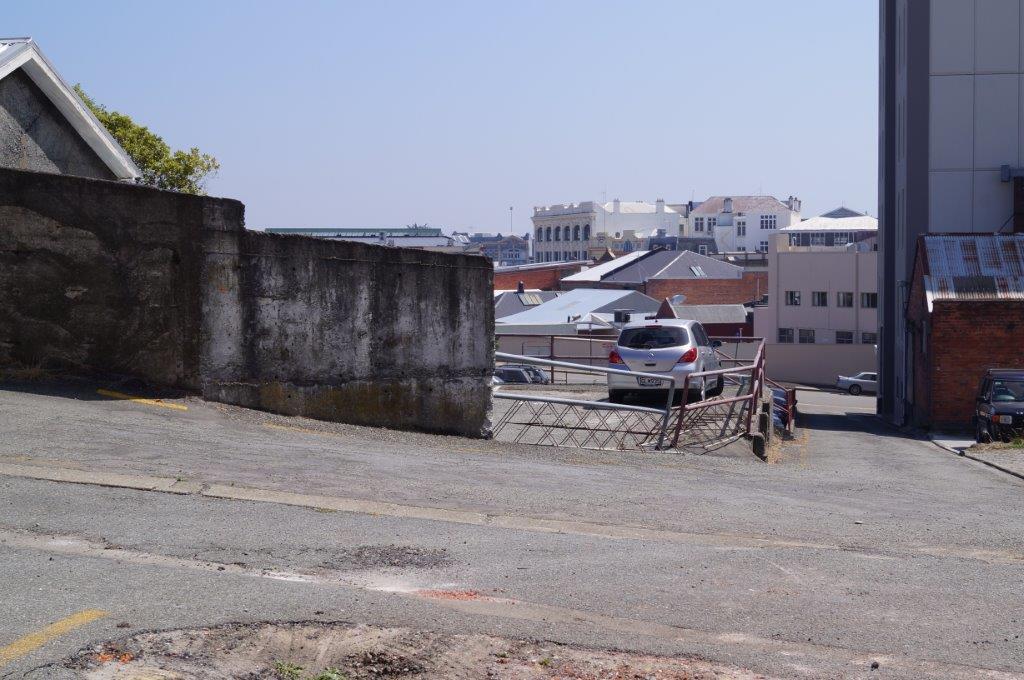
effectively. The possible extension of existing ducting through the spaces in the
ceiling over the auditorium and under floor is under review, together with possibly
siting alternative energy (electric) under the stage for forward stall heating. Such
systems are generally automated, and can be monitored with sensors and related
recording equipment.
The relocation of the existing diesel boiler from beside the loading dock to the
rear of any proposed new extension of the foyer space would enable
consideration of options for heating for the extension, and widen the loading dock
area. This option should be looked at when a decision is made on the demolition
of the Army hall.
The future of the hall building should be reviewed in conjunction with paragraph
13 (Seismic / Earthquake- prone buildings) of this section of the report.
8.
Application through the Planning process for Designations for Road Widening.
Two such designations are considered desirable, to enable purchase. Acquisition
will enhance vehicle movements for turning, and backing into the loading dock.
-
One is referred to in (5) above over a 2 metre width over 31 Barnard Street,
a council owned property.
-
The second sought is over a 2 metre depth over the rear of 33 Barnard
Street, for improved vehicle access / road widening of the service lane (a
service lane is a road by definition under the Local Government Act 1974).
9.
Removal of Right of Access over Council land parcels in favour of the Army Hall
site.
Study of Certificate of Title CB 37A/825 reveals that Lot 10, DP 9843 has a right
of way (limited as to height, presumably to incorporate the loading dock roof) over
a number of Council-owned land parcels.
It is recommended that these rights be revoked in part; to manage the
movements of pedestrian traffic. Depending on the development of the Army Hall
site, it is seen as desirable to focus pedestrian movements to the formed right of
way expressly, and confine movements from the right of way up to Barnard
Street, for safety reasons. The formed access from Barnard Street is advertised
as the pedestrian link to the Theatre and Stafford Street, but is not well lit for
night movements, and negative opportunities are known to exist.
Timaru District Council
Policy and Development Committee
#832093
12
4 March 2014
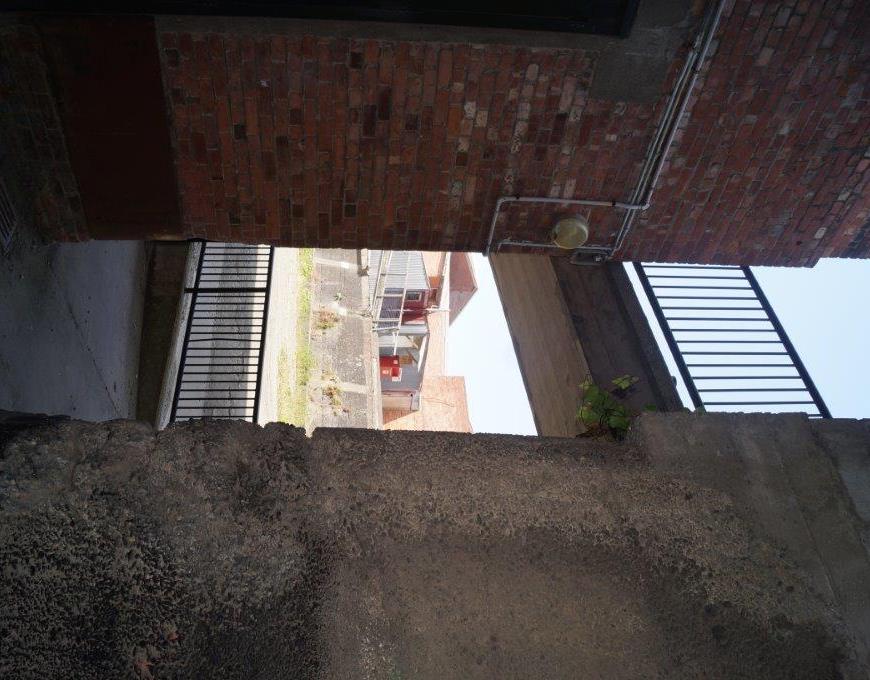
10. The installation of a gate at the end of the loading dock is viewed as a positive
dissuasion to undesirable activities.
With additional improvements to the access way (weather protection, lighting,
security) and improved access for those with mobility issues, public safety can be
enhanced.
This proposal has the support of Safer Communities and Timaru Police.
The step of removing the access rights can be done while Council owns the land
parcels. The outcome will be to direct pedestrian movement away from the
loading dock, where there is a potential for conflict when there are vehicles and
stage set preparations occurring at the rear stage door. Costs for this proposed
upgrade will be included in preparation of the 2015- 2025 LTP.
11. Green Room
There has been past reference to the wish to have a ‘Green Room’ built. A green
room is a facility for cast to relax between sets away from the stage, and busy
dressing rooms, but still with ready access to the stage. There are physical
constraints on positioning, and the value of such a facility has still to be qualified.
Its potential location would most likely be at the rear of the building above the
loading dock.
The inclusion of such a facility is something to be considered further in the event
of planning advancing for future improvements in the loading dock / service lane
area, and a decision on the future of the Army hall.
12. Removal of Surplus Buildings adjoining the Theatre.
i)
The clearance of the Army Hall building has been referred to earlier in this
section. Subject to defining an end use the building, whether it be
developed by Council or by an external party, the building does have an
existing function, for parking, or short-term leasing.
Timaru District Council
Policy and Development Committee
#832093
13
4 March 2014


In addition to the costs of demolition, there is the cost of converting the site
to a basic useful purpose.
ii)
Council has completed the demolition and removal of the non-functional
brick garage at the rear of 128 Stafford Street during the 2013/14 financial
year.
The cleared space will also provide options for a small (5 – 6 vehicles)
parking area at the rear of the Theatre. The area is currently unformed, but
presents options for alternative show vehicle parking.
iii)
The opportunity will also provide improved access to the rear of the two
shop properties at 126 and 128 Stafford Street, for their future demolition
and re- development.
The future use of the area occupied by these two shops is the point of
discussion in a later section of this report.
The redevelopment will be driven largely by external market indicators in
relation to the locality within the city.
Timaru District Council
Policy and Development Committee
#832093
14
4 March 2014
The two shops are ideally located for Council to consider its option for
expansion of the existing facilities within the ground and upstairs foyers of
the Theatre. However, the attractiveness of redevelopment would increase
if an option materializes which offers an opportunity to provide an outcome
to an identified internal or market need, or enhances/increases the present
usage of the Theatre.
In the event of the shops requiring to be cleared, accessing them from the
rear would minimize adverse effects on Stafford Street as regards traffic.
The removal of these two buildings would trigger consideration, and if
necessary, compliance with Planning rules relating to buildings in the
Commercial 1A zone, with frontage onto Stafford Street. Traditionally, all
buildings on Stafford Street have had verandahs. The verandahs on the
shops are in need of repair or removal.
Section 5.6 of the Performance Standards for Commercial 1A zones (Part
D of the District Plan) refers to verandahs specifically. It states
‘ every
building fronting Stafford Street in this zone shall, on its erection or on
being reconstructed in any way that substantially changes the face of the
building, be provided with a verandah along the full face of the building.’
The demolition of any building on a street frontage within the zone is a
discretionary activity, and as such will require a land use consent approval.
It would not be economically viable to retain the existing building fronts or
verandahs over the footpath. However, these building adjoin the Theatre,
an identified heritage site. This will have a bearing on the verandah, and
the standard and style of construction.
If necessary, the sites would be cleared and closed off to the public with
appropriate materials, e.g. slab concrete at minimum 3 metre height,
pending a final decision on its future use.
The clearance of the buildings has been evaluated for costing purposes at
$20,000.
In the event of demolition of the shop buildings being approved, there is a
cost to enclose the site from the adjoining street frontage, and adjacent
private property, with a shell of permanent material in keeping with the
surrounding buildings. Tilt slab concrete panels are deemed the most
convenient permanent material for this purpose.
Factors to consider for Re-development
The north exterior wall adjoins a private right of way serving the adjacent
property. Prior consultation and agreement for access with the adjoining
owner would be a pre-requisite, regardless of the extent of redevelopment.
The contour of the street frontage slopes downwards from the existing
Theatre – the height difference to the north wall at 128 at floor level is
950mm (measured by datum survey). The redevelopment will need to
include consideration of floor heights. There will be a difference in ground
level and height, to the rear of these buildings, in relation to the rear of the
foyer extensions completed 1993. The ground level at the rear of the
building is approximately 3 metres above the existing floor of the foyer,
which can be equated to ceiling height.
Timaru District Council
Policy and Development Committee
#832093
15
4 March 2014
This difference in levels can be used to the advantage of a future
development, with a lower floor effectively being the existing ground level of
the rear driveway access/means of escape routes for the first floor. With
further excavation of the lower level following clearance (if needed),
extended facilities or room space can be created over a longer depth of the
two sites.
The extent of depth used, and width of such extensions will accommodate
retention of means of escape requirements to the rear of the building, which
are already existent.
13. Earthquake / Seismic Strengthening
Government announced its earthquake – prone buildings policy on 7 August
2013. The intention is to introduce a nationally consistent system to identify
buildings through assessment within 5 years of the legislation taking effect.
Building owners will have 15 years to carry out strengthening work, with the
provision of the possibility of a further 10 years for buildings on Category 1
heritage buildings and those on the proposed National Historic Landmarks list.
Depending on the outcome of the assessment report, the effect of this proposed
legislative requirement may have an effect on requirements for the Theatre.
Local authorities are required to complete a seismic assessment of all
non-residential and multi-unit, multi – storey buildings in their areas within
5 years.
The required minimum standard will be 34 per cent (%) of the NBS (new building
standard).
The initial timeframe for reporting on buildings will mean that a decision on the
future and use of the Army hall building will be better made within 5 years of the
legislation being enacted.
The Theatre building is seen as an important community asset, so will be the
subject of a structural assessment report within the required statutory period. It is
considered advisable to obtain the required report as soon as practicable.
The building had seismic strengthening added to the structure in the
aforementioned foyer upgrade project of 1992/93. The work done to the building
met the required minimum level for the Building code of the day following
completion of those works, being 33%.
Discussion with the Building approvals unit suggest that there has been little
change in the loading measurement of materials since the previous upgrade,
however, the time gap will require a fresh assessment.
Until the seismic status / NBS rating is known for the existing Theatre building,
and whether any work is required / costs are known, and budgets established /
timeframes set, further expansion of the building and facilities are viewed as
being secondary. It is recommended that the report be commissioned at an early
opportunity.
Timaru District Council
Policy and Development Committee
#832093
16
4 March 2014
It is also becoming evident that for future insurance renewals, insurance
companies are requiring engineering reports to ascertain building strengths and
that relationship to the percentages set down for pre-1976 buildings in terms of
the New Building Standards (NBS).
As the predominant portion of the Theatre structure was built 1911, it will need to
be inspected to determine whether it will meet acceptable NBS requirements.
Insurance providers are also likely to impress the need for such reports as a
requisite for future cover.
While the Theatre building is viewed as a strategic asset by Council, it is
considered unlikely that in the event of theatre suffering serious damage, that it
be re-built in the same style as befits its current heritage status.
14. Installation of Counterweight
The theatre is one of the few remaining in New Zealand which uses hand lines for
the flying stage system for securing and supporting stage sets. The system is
simple in that there are no mechanical devices to raise and lower sets. A
counterweight is a desirable addition to balance the set loads and ease of
manipulation by stage hands. Theatre Design, a Christchurch based
consultancy, has offered assistance with design in this regard. It may be possible
to use locally available materials to construct it, and fund from maintenance /
existing budgets.
15. EFT–Pos
EFT-Pos services are not currently available at the Theatre. If performances /
show days are to be increased, especially evening use, the acquisition of
EFT–Pos services will become necessary. With wireless connection options
available, this suggested enhancement would be a positive move at little cost.
The cost for this is to be included in the 2014/ 15 Annual Plan.
Timaru District Council
Policy and Development Committee
#832093
17
4 March 2014
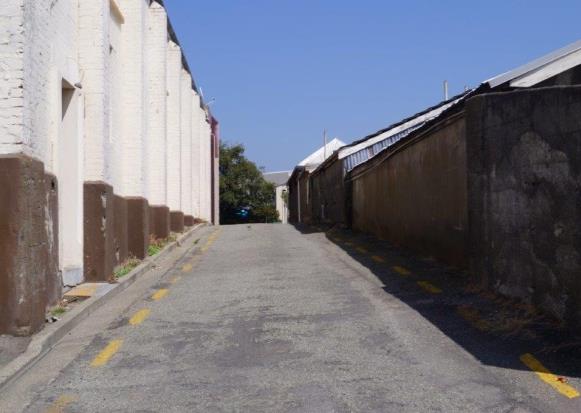
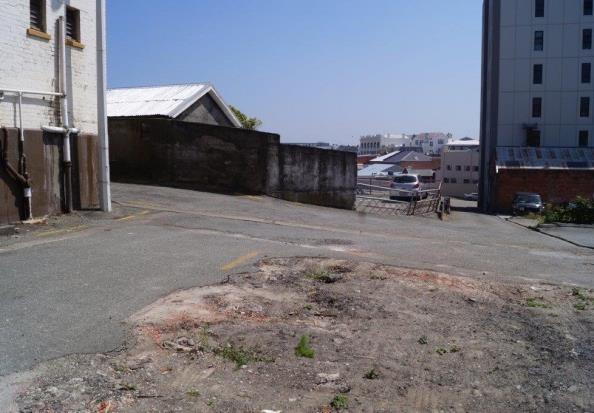
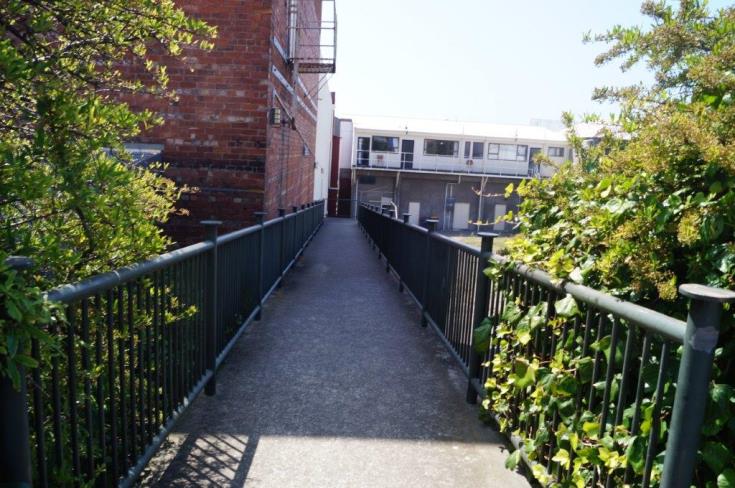
To summarise the findings and recommendations identified to date:
1.
The provision of new seating within the auditorium has been a line item within
Council budgets.
2.
The replacement of the existing seating will mean a reduction of numbers (1020
to 920). Current (2013) cost estimates range from $300,000 - $500,000,
depending on style selected and supplier. This is within the estimates provided
for budgets. ($500,000 in the 2014/15 year, and $500,000 in the 2015/16 year)
3.
The widening of the service lane will necessitate demolition of the Army Hall
building at an estimated cost of $100,000. Cost to widen the service lane,
including retaining walls for the hall site are currently estimated at (2013)
$30,000. Improvement of the turning corner where it adjoins 33 Barnard Street
will ideally need an estimated area of 48m2 from the rear of that site
4.
The use of designations to enhance the usability of the service lane should be
visited through the Planning process, and a recommendation to committee with
acquisition costs.
5.
The enhancement of the pedestrian access for improved mobility and safety of
Theatre patrons, and the removal of current access rights in favour of other
properties should be taken further, to establish costs for inclusion in future
budgets.
6.
Back of house improvements are limited by physical/building constraints, but can
largely be met progressively through existing maintenance funding.
Timaru District Council
Policy and Development Committee
#832093
18
4 March 2014
7.
The heating and air ventilation system shall be reviewed to determine whether
there is an economic method to recirculate warm air to the front stalls from the
upper seating level, as well as circulating fresh air when required. The relocation
of the diesel boiler / fuel tank to the rear of the proposed service area/ car park,
and review of installing electric heating for the front stalls is also part of the study.
8.
One building has already been demolished. Future and further such works shall
be subject to other drivers, which shall be looked at in the next section. The shop
buildings may need to be the subject of a structural inspection if they were to
remain.
9.
The expansion of Theatre facilities in to the space occupied by the two shops will
be subject to market demand.
10. A structural assessment report by a structural engineer should be commissioned
for the Theatre, to a level of information that will determine the NBS level for the
building.
Possible Extension to the Theatre
Within the Theatre
To illustrate extension options, concept drawings were sought from local architects,
DLA Architects. Two sets of end concept plans were created, one for a conference
centre / meeting room in addition to extended facilities within the potential space, and
another set depicting a similar layout, but with less emphasis on conference rooms.
The second set was adopted for costing purposes.
Background
Because of space constraints within the Theatre footprint at the time of the foyer
redevelopment in 1993, the design and layout for the ground floor toilets and bar
servery causes delays for patrons wishing to use one or both facilities during show
intermissions. This occurs frequently at shows where patron numbers are 300 +.
The numbers of cubicles/pans met the Building Code requirements in force at the time;
however the main complaint is the shortage of female facilities when show patronage is
higher.
If Council wishes to encourage more frequent use of the Theatre, increased facilities
and a wider layout to encourage better movement and patron use should be
considered, with emphasis on the ground floor.
Because seat numbers are lower upstairs (about 370 out of the total of 1020) and there
is currently no provision of access for patrons with mobility issues, the same issue of
disabled facilities is not currently a concern. However, if redevelopment of foyer
facilities is to be considered, this aspect may become a requirement of consent for the
proposed works if provision is made for a lift. If a lift is not included, it may still be
prudent to allow for constructing other disabled facilities such as complying door widths
and cubicles as future- proofing.
Timaru District Council
Policy and Development Committee
#832093
19
4 March 2014
The demolition of the two shops will afford an additional 9.6 metres frontage width and
over 20 metres site depth in which to configure additional toilets, and reposition other
service areas, such as the bar/server, and storage areas, to provide wider access
paths for foyer pedestrian traffic.
Access
The installation of a full-size lift for people (minimum dimensions 1400 x 1400, to allow
full wheelchair access) will create wider implications, such as there will be fully
accessible seating upstairs.
If this is to be considered further, the current tiered construction layout for seating will
limit the placement of such mobility-affected patrons to places adjacent to the circle
foyer entrance.
To accommodate any disabled seating upstairs, it would necessitate the removal of
existing seating (up to 12 existing seats next to the entrance aisle) but without
undertaking major modifications, it would not be feasible to construct an alternative
means of escape. There are exit doors on either side of the circle seating area, but the
sloped access ramps availing disabled access currently in place would be too steep to
meet safety standards.
To consider implementing disabled seating, it would have to be as part of an overall
development plan. In the event of a required evacuation, lifts are generally inoperable.
An alternative means of escape route would need to be built. An exit to the rear of the
building via the upstairs foyer, if it is extended is depicted on the proposed floor plan.
Discussions with Building Approvals suggest that if provision for a lift to be installed at
a later date only were allowed for, by leaving a void, then there would not be the
expectation for extending disabled facilities upstairs, until such time as a lift was to
proceed.
Toilets and Access Routes
As referred to earlier, identified issues relating to the current layout is the relationship of
the numbers of ground floor toilet facilities, access to them, and the proximity to bar
services, especially at pre-show and intermissions. The numbers may conform to the
minimum numbers for the Building Code but delays have meant patron inconvenience
becoming a negative to attracting more use.
The clearest outcome to pursue for overcoming this situation is to develop a layout for
additional facilities over the space occupied by the two shops now owned by Council.
The ground floor number is in more need of attention than the facilities upstairs;
however the respective locations of the toilets and bars on both floors should be
reviewed, with a view to improving numbers, access thereto, and as a result, enhanced
service by both facilities.
It is considered preferable that the existing foyer remain as it is structurally. There is a
good balance, both architecturally and functionally, with the entrance ramp, and paired
access ramps at ground floor, and the stairways to the upper floor. Access to the
auditorium seating at ground floor is via two separate doors, and does not need further
changes.
Currently, the ground floor means of escape meet current codes, including distances to
exits.
Timaru District Council
Policy and Development Committee
#832093
20
4 March 2014
Concept Plans
The concept plan for the ground floor B1 depicts a separation of the ground floor toilet
areas and bars, with enhanced access routes, and provision for service/storage areas
at ground floor, and an (optional) passenger lift.
The ground floor plan shows the (optional) passenger lift, and toilets adjacent to
existing services on the floor, to take advantage of the existing services for toilets, and
the deeper floor above ground level for a lift well. The gathering/ breakout area and
bar become an extension of the current foyer.
The space denoted ‘conference room’ may be adapted for Theatre service areas or
other uses.
The wider access created by the bar being moved also provides an additional meeting
/gathering area for patrons.
The upstairs foyer concept plan B2 also depicts a separation of toilets and bar areas,
the bar being adjacent to the proposed gathering / breakout area on the north side of
the building, to benefit from enhanced lighting. The proposed lift well backs on to the
bar, affording access to the conference room.
A 50 seat conference room is added to the north eastern quadrant of the floor,
accessed directly from the new entry from the foyer extension. While the meeting room
concept could be considered optional for this lower-scale development proposal, it
adds an attractive feature for the facility, taking advantage of the elevated northern side
of the building, with views. Parking is available close by, on Barnard Street.
The food preparation kitchen access leads directly to the new entry and break out area,
and the store can be accessed from the building’s rear entrance fro service vehicles,
with a connecting door to the kitchen.
There is also the additional opportunity for means of escape to the rear of the building
into the service lane / proposed service parking area for the upstairs space. The
ground floor means of escape would be better served being made to existing egress
points to Stafford Street, with appropriate fire protection systems in place, as opposed
to creating an access to the rear of the building (by way of a ramp). The extension of
the existing fire sprinkler system into the proposed new area will enable the Building
code standard relating to minimum escape distances to be well achieved.
The development of the Theatre extensions would be as a staged process, which
would enable Council to establish clear budget considerations.
The shops themselves are not in a fit state for re-leasing or use. It is recommended
that the two properties should be cleared, at an estimated cost of $20,000.
The two shops are closed, but the condition of both is such that their removal is seen
as a way to clear the sites, and the existing verandahs over the footpaths being
replaced.
In order to retain a secure area, and create building cells for future developments,
suitable exterior wall material, meeting current seismic strength ratings, such as
concrete tilt slabs, could be erected to create a ground floor and first floor space.
Timaru District Council
Policy and Development Committee
#832093
21
4 March 2014
The removal of the shops also removes any potential hazards and unattractive
buildings.
The future development of the interior of the two floors can then be undertaken as
demand for upgraded facilities is supported by market evidence.
The ground floor should be the initial focus for future development within the expanded
area, with additional toilets, and service/storage areas to the rear of the space. The
Stafford Street side would lend towards a social gathering area, with an option for a
bar/servery area, linking though to the existing foyer.
A concept plan layout depicts the potential internal configuration, with an emergency
exit on the first floor for escape purposes to the rear of the building. The means of
escape for the ground floor shall be to Stafford Street via a route with sprinkler
protection.
There is less pressure on the upstairs floor for additional facilities for toilets, as there
are fewer numbers in attendance. However, upstairs would be the preferential space
for providing a new facility for the Theatre.
There are some comparatively uncomplicated steps which Council could look to take
over a period of 1 – 2 years to initiate an upgrade of the Theatre’s facilities.
Due to the estimated cost of the demolition of the Army hall at $100k, and no confirmed
use for the hall site (at the time of writing), it would be preferable to establish a site use,
and a value, either for a Council project or an external use prior to clearing the building.
Hotel/Conference Centre
The Hydro Grand, the preferred site identified in the 2008 ABDT report because of its
site views and proximity to Caroline Bay and Timaru CBD, was purchased privately in
March 2013. The new owner is reviewing options for the site, and the vacant sites also
acquired adjacent to the hotel building.
Realistically, the held opinion is that the South end of Timaru currently just does not
have the pulling power to attract such a development, as it does not have the variety
and standard of retail outlets considered desirable to attract.
The large majority of privately owned sites around the Theatre are small land parcels,
in singular ownership with buildings on them which would most likely not be adaptable
to a larger development, without an accumulation of land parcels.
The Army Hall will need to be considered for demolition at some time in the future. It is
currently used for low-level Council purposes, and should the tenant vacate the north
side, its future would be for short-term purposes only, as permitted on its current zoning
(Commercial 1B).
It is proposed that the building remain for 2 – 3 years. A combination of additional
office/parking is one option for the future. As an alternative should a business
development study of the section of the Timaru business area encompassing the
Stafford/George/Barnard/Woollcombe block, or George/Stafford/Turnbull identify
opportunities for 31 Barnard Street, and then Council’s asset may have a strategic
value.
Timaru District Council
Policy and Development Committee
#832093
22
4 March 2014
External Peer Review
The proposal for the extension of the Theatre and the upgrading of facilities has been
reviewed by Roger Shand, a former founder and partner in the firm Shand Shelton, a
Wellington – based firm of project managers and architects, with a specialty focus on
theatres.
The focus of the review was the identification of items for future consideration,
including the proposed foyer extension, vehicular access / parking, and seating
options. The site was visited 6 September 2013.
The focal suggestions emanating from the visit was to focus attention on the
forthcoming Seismic strength / earthquake survey, the access routes to the loading
bay, and the positioning of the proposed new counterweight system.
Mr Shand has offered his expertise to assist with guidance on any further
enhancements.
Options for Council
As identified earlier, there are a number of identified steps which Council could
consider to enhance the services of the Theatre, to be put forward to future Annual
Plans and Long Term Plans for funding, with timetables/financial periods to undertake
approved works.
Estimations have been inserted where known.
The focus of the study has become over the time in preparation has the identification of
items deemed worthy of attention by Council to enhance its asset.
It is recommended that those identified areas be dealt with in Stages. The first stage
would be guided by legislation (building inspection, access rights).
The seismic survey has been recommended as a first step. If the outcome reveals the
need for a strengthening upgrade of the Theatre, it should be dealt with expeditiously.
Other items for consideration at an early stage are the extension of the pedestrian
ramp on the south side, heating / ventilating (following tests and recommendations),
the proposed stage counterweight and auditorium seating.
The second stage would involve the clearance of those surplus buildings and approved
improvements to existing facilities within the Theatre, such as service lane/ loading
bay, and seating.
The third stage would be subject to market forces, which is the foyer extension /
meeting rooms.
The current Long Term Plan (2012 / 2022) has identified expenditure for the 2014/15
and 2015/16 years of $500,000 in of each of those years, for replacement seating. The
upgrading of fly floor equipment is an ongoing item, to preserve standards.
Initially, a further report should be prepared for Council, prior to the preparation of the
long Term plan review, outlining the main items which have been captured in this
report, with a proposal for priorities to be addressed.
Those priorities should address the current building functions, with costs and
timeframes.
Timaru District Council
Policy and Development Committee
#832093
23
4 March 2014
Suggested Course of Action:
(1)
Arrange for obtaining a registered structural engineer’s structural report for the
Theatre. This point is seen as pivotal to determining further progress.
(2)
On receipt of the structural engineering report, and review its findings. If
structural upgrading is required, prepare a cost/ benefit analysis in terms of the
existing building structure. Report the outcome of the analysis to Council, and in
the event of items requiring attention, for future funding planning in the Long
Term Plan. This item was also identified as a prime focus in the peer review.
(3)
Review the feasibility of clearing the two shops on 126 and 128 Stafford Street,
with costs for demolition and making the site safe / secure with concrete tilt slab
panels to create a shell, pending a decision for later development.
(4)
Investigate the upgrade of the pedestrian access way from the Barnard Street car
park to Stafford Street, with emphases on enhancing safety and mobility options.
(5)
Consider suggested options for improving vehicle turning and backing into the
Theatre loading dock from Barnard Street. Initial focus on the acquisition of land
from the rear 2 – 3 metres of 33 Barnard Street, with emphasis on negotiation.
(see Aerial - Appendix 2)
(6)
Consider the removal of rights of access in favour of the Army Hall site across
other Theatre land parcels. To consider in due course, the installation of barriers
in conjunction with (5).
(7)
Obtain costs for building material for the construction of additional room space to
replace the shop front properties. Renovation and refurbishment would be
allowed for at a later date.
(8)
Creation of a 6-bay parking area at the rear of shops for Theatre service vehicles.
(9)
Continue investigations into options for efficient heating systems, including
relocation of boiler to the rear of the proposed service car park (8) above. (See
Aerial - Appendix 2)
Proposed Schedule
To date, the following items have been identified, (costs shown here as estimations
only). Further qualification of each of these figures will be investigated for each stage of
development, subject to approval for works.
Stage One
$
1.
Structural inspection report ( recommended)
10,000
2.
Additional heating / ventilation upgrades.
3.
Safety improvements for pedestrian access / gates.
Stage Two
1.
Demolition of surplus shop buildings, including securing site with tilt slab panels.
2.
Seating for auditorium.
Timaru District Council
Policy and Development Committee
#832093
24
4 March 2014
Stage Three
1.
Demolition of Army hall building
2.
Acquisition of land for improved access
3.
Formation of wider access lane
4.
Formation of service parking area – rear of Theatre
5.
Legalisation costs – acquisition, land purchase.
6.
Proposed extension of foyer facilities
Costs can be acquired and reviewed at a later date for future Annual Plans and Long
Term Plans for those items accepted by Council as being deemed reasonable for
improving the Theatre.
Recommendations
1.
That this report be received and noted.
2.
That a Structural report be obtained for the Theatre building from a
registered structural engineer, with the cost to be funded from the
contingency fund.
3.
That a detailed report on seating options be prepared, with budget to be
allowed for in the 2015/16 financial year.
4.
That heating / ventilation upgrades be progressed, and be considered for
inclusion in the 2014/15 Annual Plan.
5.
That the pedestrian access be progressed and considered for inclusion in
the 2014 /15 Annual Plan.
6.
That the following items be considered following receipt of the structural
report for inclusion in the next Long Term Plan, as necessary:
-
Vehicle access improvements and removal of right of way conditions
-
Demolition of Barnard Street and Stafford properties.
-
Creation of additional parking area at the rear of the Theatre.
-
Development options for the enhancement of the Theatre foyer
facilities, including extensions to include meeting / conference
facilities.
Timaru District Council
Policy and Development Committee
#832093
25
4 March 2014
Appendices
1. Aerial photograph, depicting Council owned properties.
2. Aerial, depicting proposed external Stage 2 upgrades.
3. Architect’s plans for foyer extensions (DLA Architects)
i)
Facilities and conference rooms (Version 1 - A, B)
ii)
Facilities and meeting rooms (Version 2 – A, B)
Timaru District Council
Policy and Development Committee
#832093
26
4 March 2014
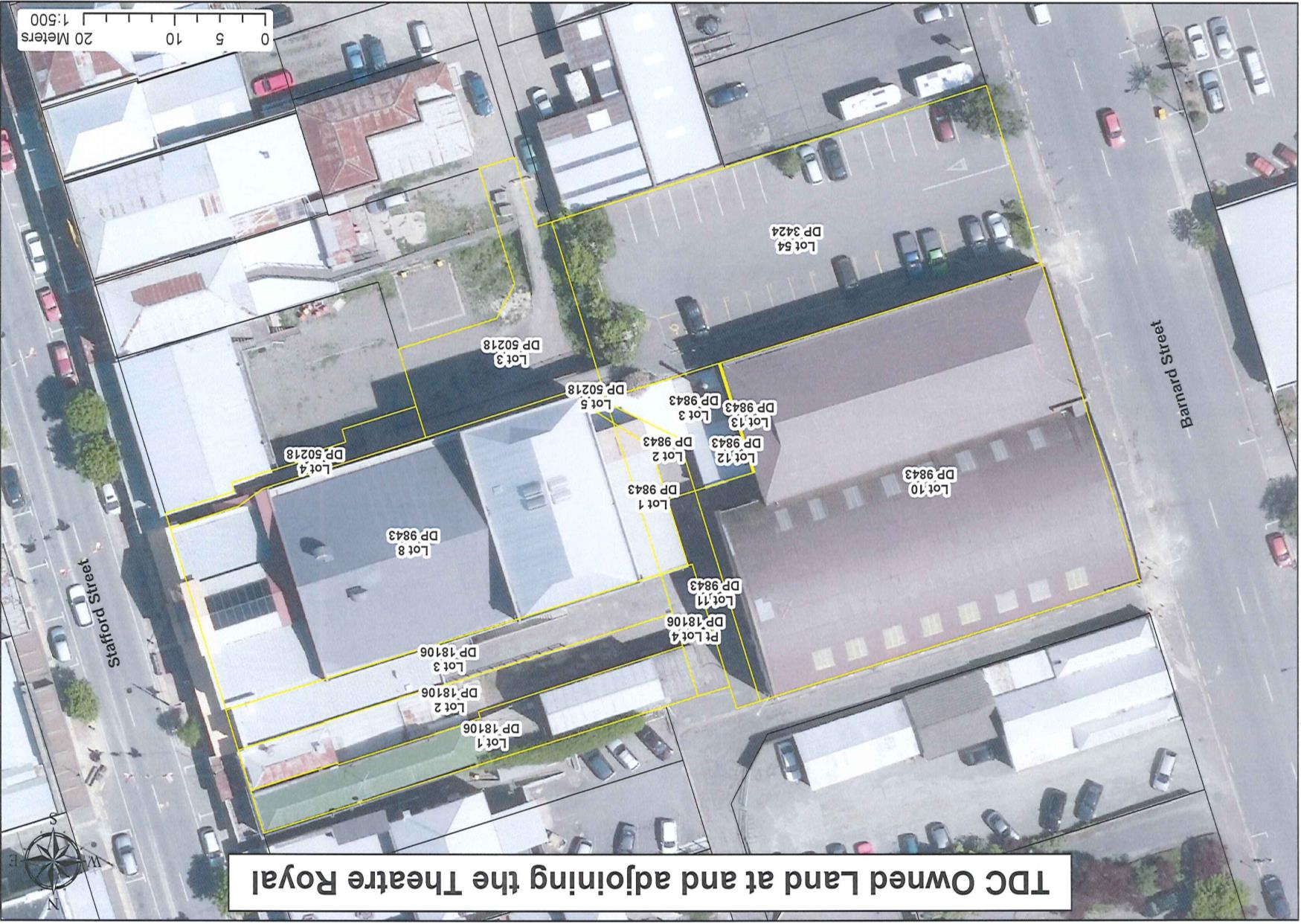
Appendix 1
Timaru District Council
Policy and Development Committee
#832093
27
4 March 2014
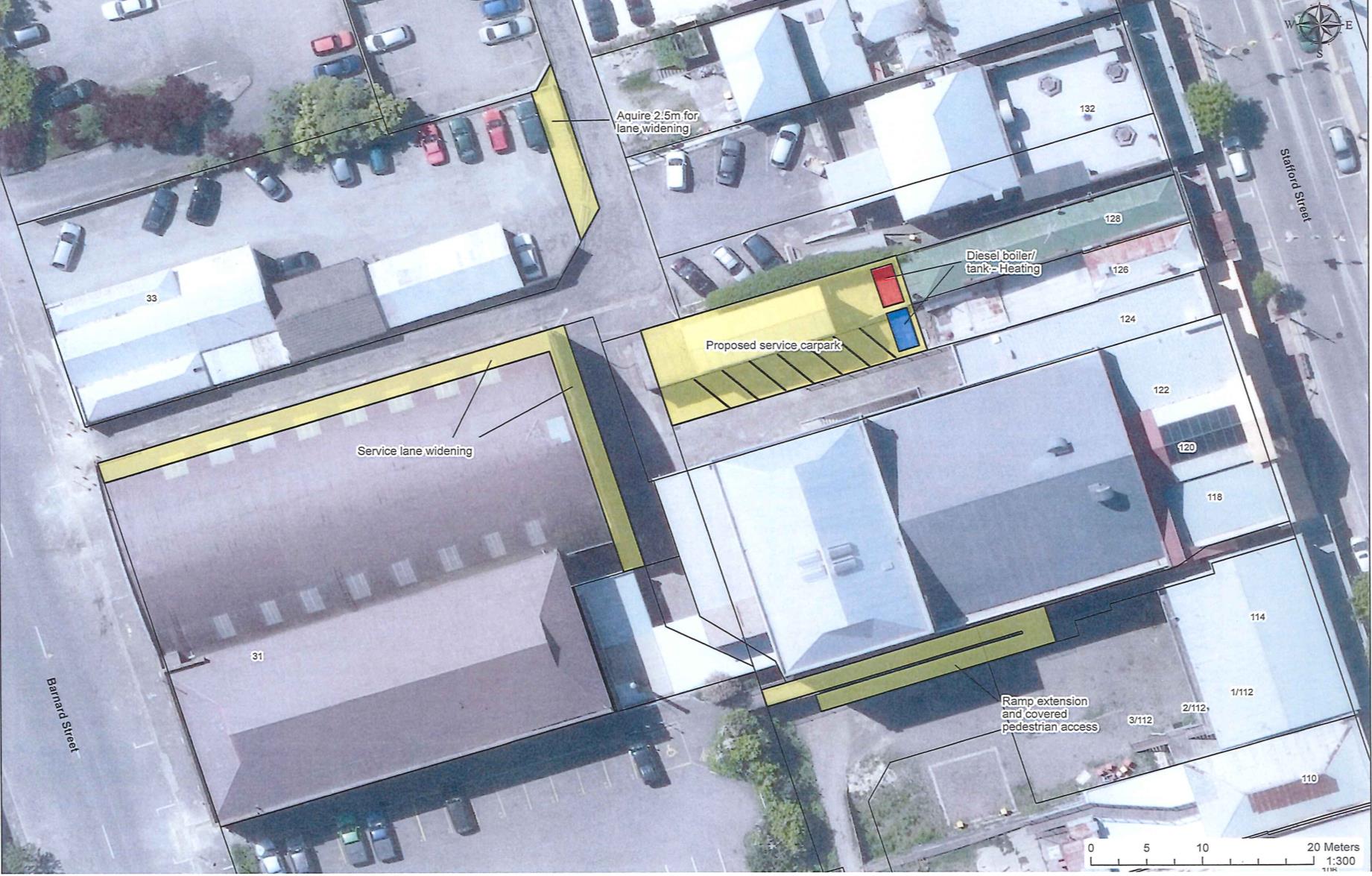
Appendix 2
Timaru District Council
Policy and Development Committee
#832093
28
4 March 2014
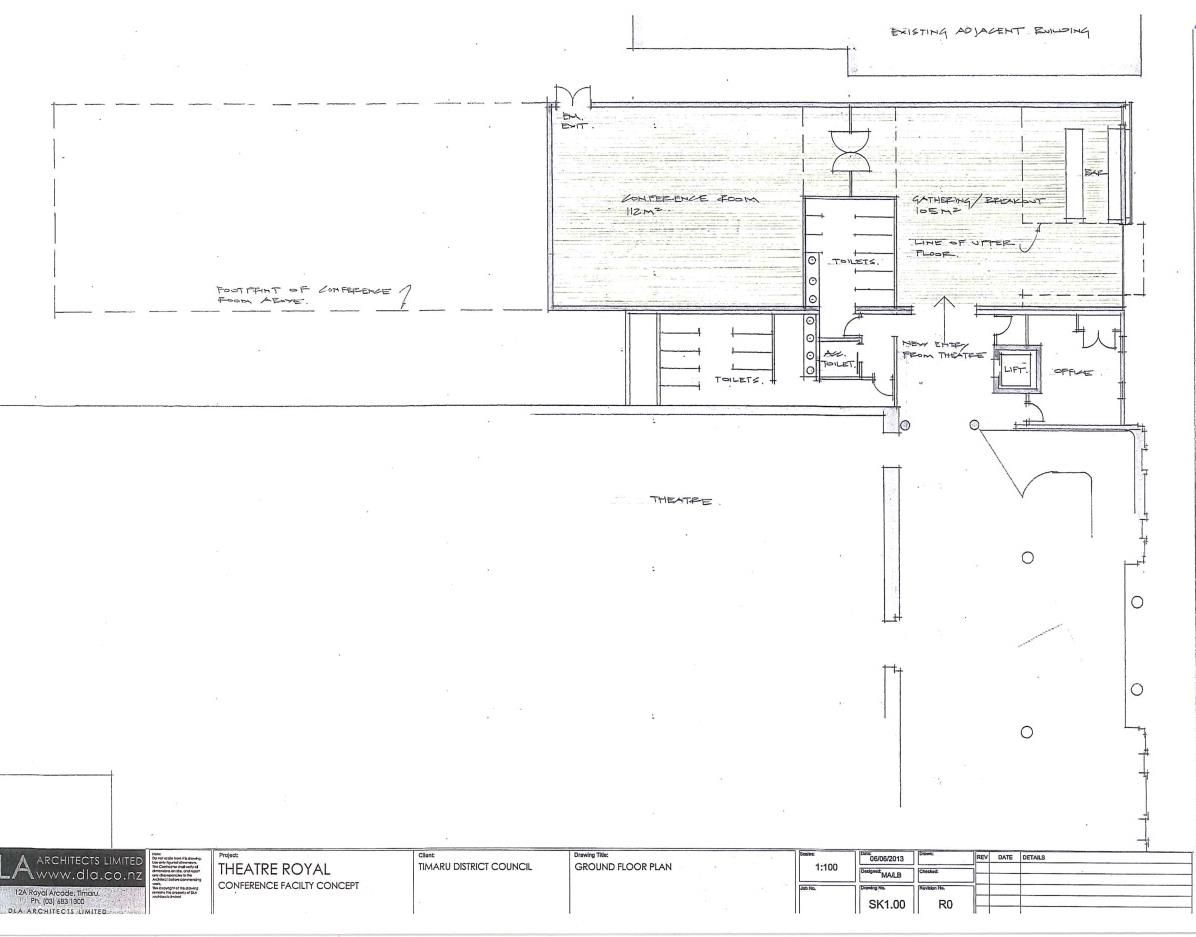
Appendix 3 (Version 1 A)
Timaru District Council
Policy and Development Committee
#832093
29
4 March 2014
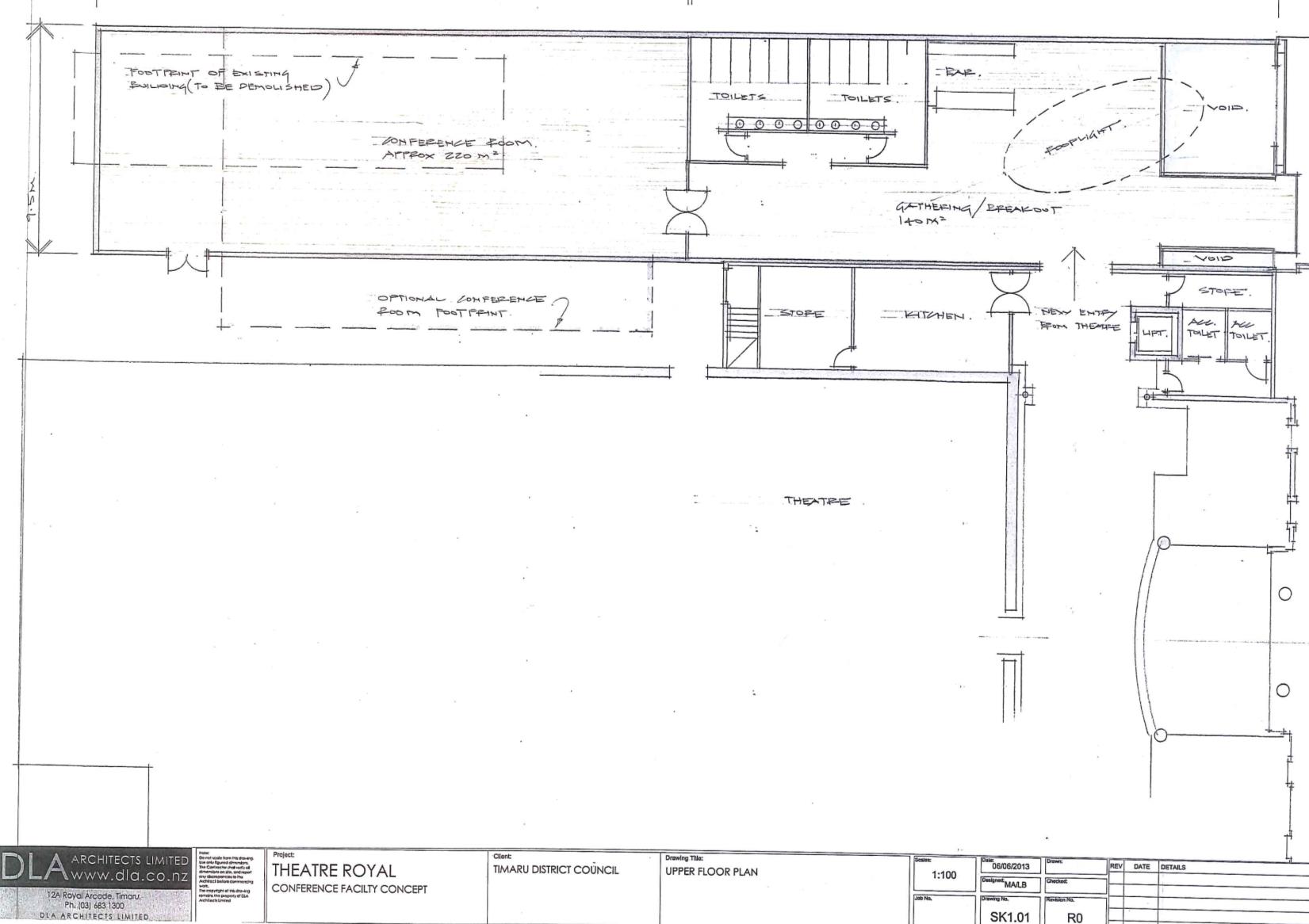
Appendix 3 (Version 1 B)
Timaru District Council
Policy and Development Committee
#832093
30
4 March 2014
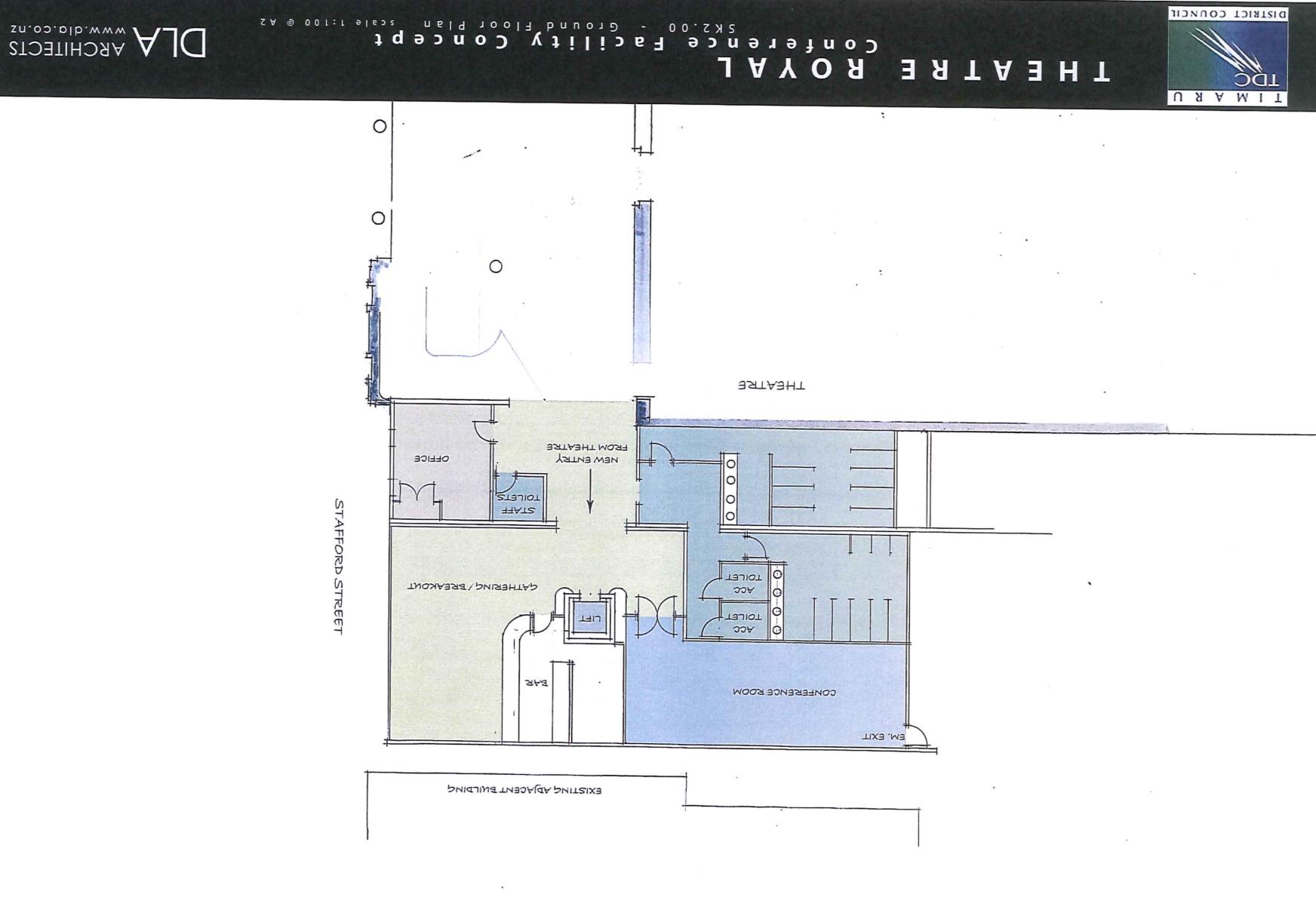
Appendix 3 (Version 2 – A)
Timaru District Council
Policy and Development Committee
#832093
31
4 March 2014

Appendix 3 (Version 2 B)
Timaru District Council
Policy and Development Committee
#832093
32
4 March 2014



































